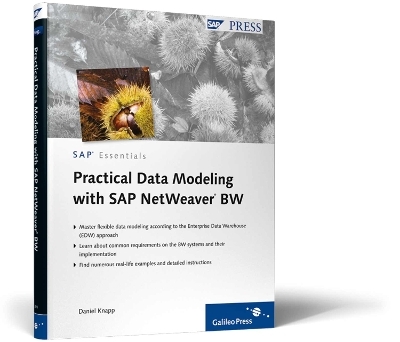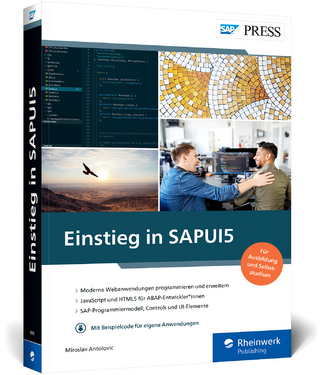
Practical Data Modeling with SAP NetWeaver BW
SAP Press (Verlag)
978-1-59229-301-8 (ISBN)
- Titel ist leider vergriffen;
keine Neuauflage - Artikel merken
Daniel Knapp joined IXULT AG in 2004 as an SAP Technology Consultant. Since the introduction of Rich Internet Applications, he has been working as a developer in the Flash and Flex environments. After earning a degree in information technology, he gathered much experience in numerous projects. He has a profound knowledge of SAP systems.
1 ... Introduction ... 11 ... 1.1 ... Introduction to SAP NetWeaver BW ... 11 ... 1.2 ... SAP s Data Model in Business Content ... 13 ... 1.3 ... Structure of the Book ... 16 ... 1.4 ... Target Groups ... 17 2 ... The Enterprise Data Warehouse (EDW ... 19 ... 2.1 ... Introduction to the EDW ... 19 ... ... 2.1.1 ... The Corporate Information Factory (CIF ... 19 ... ... 2.1.2 ... From the CIF to the EDW ... 22 ... ... 2.1.3 ... Denominations of the Layers ... 24 ... ... 2.1.4 ... Costs for Setting Up an EDW ... 25 ... 2.2 ... Layer 1 Data Acquisition Layer ... 27 ... ... 2.2.1 ... Number of Extracted Data ... 27 ... ... 2.2.2 ... Handling Business Content ... 28 ... ... 2.2.3 ... Cleansing of Data ... 28 ... ... 2.2.4 ... Data Storage ... 29 ... 2.3 ... Layer 2 EDW Layer ... 30 ... ... 2.3.1 ... Storage of Data ... 30 ... ... 2.3.2 ... Transformation in the EDW Layer ... 31 ... 2.4 ... Layer 3 ODS Layer ... 34 ... 2.5 ... Layer 4 ADM Layer ... 35 ... ... 2.5.1 ... Objects in the Layer ... 35 ... ... 2.5.2 ... Type of Data Transfer Processes (DTPs ... 36 ... ... 2.5.3 ... Storage of Data ... 36 ... ... 2.5.4 ... Reporting at the ADM Layer ... 37 ... 2.6 ... New Requirements in the EDW ... 38 ... ... 2.6.1 ... Update of Characteristics ... 39 ... ... 2.6.2 ... Creation of Key Figures ... 40 ... ... 2.6.3 ... Extension of the EDW Model ... 40 ... 2.7 ... Advantages and Disadvantages of an EDW ... 42 ... 2.8 ... Variations in the EDW Concept ... 44 ... ... 2.8.1 ... Variation 1 Decrease of the Data Acquisition Layer ... 44 ... ... 2.8.2 ... Variation 2 Performance Increase of the ETL Process ... 46 ... ... 2.8.3 ... Variation 3 Prevention of Redundancies ... 47 ... ... 2.8.4 ... Variation 4 Increase of the Reporting Performance ... 48 ... ... 2.8.5 ... Variation 5 Increase of the Flexibility for New Requirements ... 49 ... 2.9 ... Summary ... 49 3 ... Development of an Enterprise Data Warehouse (EDW) Based on Examples ... 51 ... 3.1 ... Introduction of the Example ... 51 ... ... 3.1.1 ... HCM Infotypes ... 52 ... ... 3.1.2 ... Requirements on the Application ... 54 ... 3.2 ... Concept of the EDW ... 55 ... ... 3.2.1 ... Determining Required Characteristics ... 55 ... ... 3.2.2 ... Determining the Data Origin ... 55 ... ... 3.2.3 ... Reference to Business Content ... 56 ... ... 3.2.4 ... Designing the Data Model ... 57 ... ... 3.2.5 ... Designing the Extraction Transformation Loading (ETL) Process ... 58 ... ... 3.2.6 ... Other Special Features of the SAP ERP HCM System ... 60 ... 3.3 ... Implementing the DataSources ... 62 ... ... 3.3.1 ... Activating the DataSources from Business Content ... 63 ... ... 3.3.2 ... Creating Views ... 64 ... ... 3.3.3 ... Creating Customer-Specific DataSources ... 66 ... 3.4 ... Designing the Basic Structure in the BW System ... 69 ... ... 3.4.1 ... Replicating the DataSources ... 69 ... ... 3.4.2 ... Creating InfoAreas ... 71 ... 3.5 ... Creating InfoObjects ... 71 ... 3.6 ... Modeling the Data Acquisition Layer ... 73 ... ... 3.6.1 ... Modeling the Master Data ... 74 ... ... 3.6.2 ... Modeling the Transaction Data ... 76 ... 3.7 ... Modeling the EDW Layer ... 78 ... ... 3.7.1 ... Modeling the Master Data ... 79 ... ... 3.7.2 ... Modeling the Transaction Data ... 81 ... 3.8 ... Modeling the ADM Layer ... 84 ... ... 3.8.1 ... Modeling the Headcount (GP3_PB ... 85 ... ... 3.8.2 ... Modeling the Personnel Actions (GP3_PM ... 88 ... ... 3.8.3 ... Modeling the Payment Analysis (GP3_PY ... 90 ... ... 3.8.4 ... Modeling the Reporting Layer ... 91 ... 3.9 ... Implementation of the Master Data Transformations ... 93 ... ... 3.9.1 ... Transformations of the DataSources to the A Layer ... 94 ... ... 3.9.2 ... Transformations from the A Layer to the EDW Layer ... 96 ... ... 3.9.3 ... Transformations from the EDW Layer to the A Layer ... 102 ... 3.10 ... Implementation of the Transaction Data Transformations ... 104 ... ... 3.10.1 ... Transformations of the DataSources to the A Layer ... 104 ... ... 3.10.2 ... Transformations from the A Layer to the EDW Layer ... 104 ... ... 3.10.3 ... Transformations from the EDW Layer to the ADM Layer ... 108 ... 3.11 ... Summary ... 112 4 ... Extension of the Enterprise Data Warehouse (EDW ... 113 ... 4.1 ... Description of the New Requirements ... 113 ... ... 4.1.1 ... New Requirements of the Business Department ... 113 ... ... 4.1.2 ... Classification of the Requirements ... 113 ... 4.2 ... Update of Characteristics ... 114 ... 4.3 ... Extension of the EDW Model ... 116 ... ... 4.3.1 ... Extensions in the Source System ... 116 ... ... 4.3.2 ... Extension of the Data Model ... 119 ... ... 4.3.3 ... Extension of the ETL Process ... 123 ... ... 4.3.4 ... Extension of the Process Chains ... 126 ... 4.4 ... Summary ... 128 5 ... Usual Requirements on Business Warehouse (BW) Systems ... 129 ... 5.1 ... Historization of Objects ... 130 ... ... 5.1.1 ... Options for the Historization in SAP NetWeaver BW ... 130 ... ... 5.1.2 ... Type and Impact of the Modeling on the Historization ... 134 ... 5.2 ... Number of Objects to be Included ... 135 ... ... 5.2.1 ... Impact on the InfoCube ... 135 ... ... 5.2.2 ... Methods for Modeling Many Objects ... 136 ... 5.3 ... Admission of Future Data ... 146 ... 5.4 ... Summary ... 148 6 ... Load Control ... 151 ... 6.1 ... Principles of Data Currency ... 151 ... ... 6.1.1 ... Historical Scenarios ... 152 ... ... 6.1.2 ... Frequency of Data Update ... 154 ... 6.2 ... Load Control with SAP NetWeaver BW ... 155 ... 6.3 ... Designing a Simple Load Control ... 156 ... 6.4 ... Designing a Complex Load Control ... 162 ... ... 6.4.1 ... Concept of the Load Control ... 163 ... ... 6.4.2 ... Implementation of the Load Control ... 164 ... 6.5 ... Summary ... 176 A ... Literature ... 179 B ... List of Abbreviations ... 181 C ... Glossary ... 183 D ... InfoObjects from Business Content ... 185 E ... The Author ... 187
| Erscheint lt. Verlag | 30.1.2010 |
|---|---|
| Reihe/Serie | SAP Essentials | SAP Press |
| Verlagsort | Maryland |
| Sprache | englisch |
| Maße | 175 x 229 mm |
| Themenwelt | Mathematik / Informatik ► Informatik ► Netzwerke |
| Informatik ► Weitere Themen ► SAP | |
| ISBN-10 | 1-59229-301-8 / 1592293018 |
| ISBN-13 | 978-1-59229-301-8 / 9781592293018 |
| Zustand | Neuware |
| Informationen gemäß Produktsicherheitsverordnung (GPSR) | |
| Haben Sie eine Frage zum Produkt? |
aus dem Bereich


